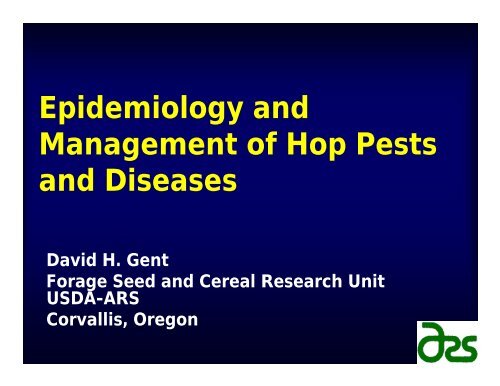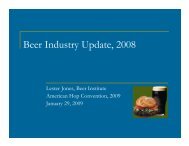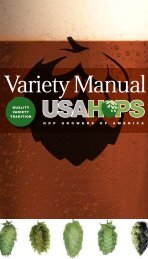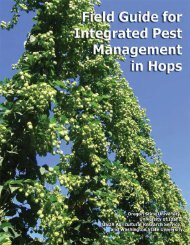Epidemiology and Management of Hop Pests and Diseases
Epidemiology and Management of Hop Pests and ... - USA Hops
Epidemiology and Management of Hop Pests and ... - USA Hops
- No tags were found...
Create successful ePaper yourself
Turn your PDF publications into a flip-book with our unique Google optimized e-Paper software.
<strong>Epidemiology</strong> <strong>and</strong><strong>Management</strong> <strong>of</strong> <strong>Hop</strong> <strong>Pests</strong><strong>and</strong> <strong>Diseases</strong>David H. GentForage Seed <strong>and</strong> Cereal Research UnitUSDA-ARSCorvallis, Oregon
Acknowledgement <strong>of</strong> Collaborators• Collaborators– OSU: Cindy Ocamb, Glenn Fisher/Amy Dreves,Vaughn Walton– WSU: Ken Eastwell, Gary Grove/Mark Nelson,David James, Steve Kenny– UI: Jim Barbour– ARS: John Henning/Shaun Townsend– University <strong>of</strong> Tasmania: Sarah Pethybridge,Frank Hay– Sustainability Victoria: Trish McGee
Compendium <strong>of</strong> <strong>Hop</strong><strong>Diseases</strong>, Arthropod<strong>Pests</strong>, <strong>and</strong> Disorders•Publishing 2008 or early2009•Updated, comprehensive,authoritative, <strong>and</strong> modernaccount <strong>of</strong> known hopdiseases <strong>and</strong> arthropodpests•Contributions from all <strong>Hop</strong>Research CouncilsupportedIPMresearchersEdited byW. F. MahaffeeS. J. Pethybridge <strong>and</strong>D. H. Gent•Assist in diagnosis <strong>of</strong> pestproblems in field lab, <strong>and</strong>clinic, <strong>and</strong> provide IPMrecommendations•Over 150 color images
Financial Support• Busch Agricultural Resources Inc.• <strong>Hop</strong> Products Australia, Hobart Tasmania, Australia• John I. Haas, Inc.• Miller Brewing Co.• Oregon <strong>Hop</strong> Commission• Roy Farm, Inc.• Sierra Nevada Brewing Co.• S.S. Steiner Inc.• University <strong>of</strong> Tasmania• U.S.Department <strong>of</strong> Agriculture, Ag. Research Service• U.S. <strong>Hop</strong> Industry Plant Protection Committee• Washington <strong>Hop</strong> Commission
Overall Project Objective• Integrate <strong>and</strong> develop coordinatedproduction strategies that reduceproduction input costs <strong>and</strong> crop lossesfrom powdery <strong>and</strong> downy mildew by atleast 30%
2007 Objectives <strong>and</strong> Progress1. Quantify environmental conditions <strong>and</strong> productionpractices that favor or limit downy mildew <strong>and</strong>powdery mildew epidemics:• Long term project in progress2. Characterize metalaxyl insensitivity in P. humuli:• Completed 20073. Develop molecular detection methods P. humuli:• Laboratory validation <strong>and</strong> years 1 <strong>and</strong> 2 <strong>of</strong> field studiescompleted; field studies to be completed 2008.• Phylogenetic studies underway with Pseudoperonospora spp.4. Identify fungicide programs that maximizeconservation biocontrol <strong>of</strong> arthropod pests:• Year 1 study completed; Current study to be completed 2009.Washington <strong>and</strong> Idaho data by D. James <strong>and</strong> J. Barbour.
• Johnson (1991) GDD predictsemergence <strong>of</strong> basal spikes at 111.3GDD C from 1 Feb.
Predicted Primary Spike Emergence by GrowingDegree-Day Model, Corvallis, OR 200530025014 March: Nugget15 March: Glacier18 March: GlacierGDD (6.5C base)2001501001201141115001-Feb 15-Feb 1-Mar 15-Mar 29-Mar 12-Apr 26-Apr
160Accumulated GDD, 2006140120GDD (base 6.5C)100806080105100402024 March: 2 Willamette yards28 March: 1 Nugget31 March: 5 Nugget & Will.01-Feb 13-Feb 25-Feb 9-Mar 21-Mar 2-Apr 14-AprDate
Accumulated GDD, 2007250200GDD (base 6.5C)1501001031351061575001-Feb 15-Feb 1-Mar 15-Mar 29-Mar 12-AprDate
Downy Mildew Severity AmongBasal spik es per hi605040302010Model-aided TreatmentsWaterSt<strong>and</strong>ardModelCu ModelAl Model03-Mar 24-Mar 14-Apr 5-May 26-May 16-Jun 7-Jul 28-Jul 18-Aug 8-SepDate
Air Sampling forDowny Mildew•Benefits:– Another piece <strong>of</strong>scouting informationwhen considering aspray– Use to time start <strong>of</strong>spray program– Help guide timing <strong>of</strong>late season sprays
hopcucurbitPCR Detection <strong>of</strong> Downy Mildew460 470 480 490 500 510 520 530 540....|....|....|....|....|....|....|....|....|....|....|....|....|....|....|....|....|....|TGTCTTGCGGCTAATTTTAGAATTGACTGCGAGTCCTTTGAAATGTACAGAACTGTACTTCTCTTTGCTCGAAAAGTGTGGCGTTGCTGGTGTCTTGCGGCTAATTTTCGAATTGACTGCGAGTCCTTTGAAATGTACAGAACTGTACTTCTCTTTGCTCGAAAAGTGTGGCGTTGCTGGTGTCTTGCGGCTAATTTTAGAATTGACTGCGAGTCCTTTGAAATGTACAGAACTGTACTTCTCTTTGCTCGAAAAGTGTGGCGTTGCTGGTGTCTTGCGGCTGATTTTCGAATTGACTGCGAGTCCTTTGAAATGTACAGAACTGTACTTCTCTTTGCTCGAAAAGTGTGGCGTTGCTGGTGTCTTGCGGCTAATTTTAGAATTGACTGCGAGTCCTTTGAAATGTACAGAACTGTACTTCTCTTTGCTCGAAAAGTGTGGCGTTGCTGGTGTCTTGCGGCTAATTTTAGAATTGACTGCGAGTCCTTTGAAATGTACAGAACTGTACTTCTCTTTGCTCGAAAAGTGTGGCGTTGCTGGTGTCTTGCGGCTAATTTTAGAATTGACTGCGAGTCCTTTGAAATGTACAGAACTGTACTTCTCTTTGCTCGAAAAGTGTGGCGTTGCTGGTGTCTTGCGGCTAATTTTAGAATTGACTGCGAGTCCTTTGAAATGTACAGAACTGTACTTCTCTTTGCTCGAAAAGTGTGGCGTTGCTGGTGTCTTGCGGCTAATTTTAGAATTGACTGCGAGTCCTTTGAAATGTACAGAACTGTACTTCTCTTTGCTCGAAAAGTGTGGCGTTGCTGGTGTCTTGCGGCTAATTTTAGAATTGACTGCGAGTCCTTTGAAATGTACAGAACTGTACTTCTCTTTGCTCGAAAAGTGNGGCGTTGCTGGTGTCTTGCGGNTAATTTTAGAATTGACTGCGAGTCCTTTGAAATGTACAGAACTGTACTTCTCTTTGCTCGAAAAGTGTGGCGTTGCTGGTGTCTTGCGGCTAATTTTAGAATTGACTGCGAGTCCTTTGAAATGTACAGAACTGTACTTCTCTTTGCTCGAAAAGTGTGGCGTTGCTGGTGTCTTGCGGCTAATTTTAGAATTGACTGCGAGTCCTTTGAAATGTACAGAACTGTACTTCTCTTTGCTCGAAAAGTGTGGCGTTGCTGGTGTCTTGCGGCTAATTTTCGAATTGACTGCGAGTCCTTTGAAATGTACAGAACTGTACTTCTCTTTGCTCGAAAAGTGTGGCGTTGCTGGTGTCTTGCGGCTAATTTTCGAATTGACTGCGAGTCCTTTGAAATGTACAGAACTGTACTTCTCTTTGCTCGAAAAGTGTGGCGTTGCTGGTGTCTTGCGGCTAATTTTCGAATTGACTGCGAGTCCTTTGAAATGTACAGAACTGTACTTCTCTTTGCTCGAAAAGTGTGGCGTTGCTGGTGTCTTGCGGCTAATTTTCGAATTGACTGCGAGTCCTTTGAAATGTACAGAACTGTACTTCTCTTTGCTCGAAAAGTGTGGCGTTGCTGGTGTCTTGCGGCTAATTTTCGAATTGACTGCGAGTCCTTTGAAATGTACAGAACTGTACTTCTCTTTGCTCGAAAAGTGTGGCGTTGCTGGTGTCTTGCGGCTAATTTTCGAATTGACTGCGAGTCCTTTGAAATGTACAGAACTGTACTTCTCTTTGCTCGAAAAGTGTGGCGTTGCTGGTGTCTTGCGGCTAATTTTCGAATTGACTGCGAGTCCTTTGAAATGTACAGAACTGTACTTCTCTTTGCTCGAAAAGTGTGGCGTTGCTGGTGTCTTGCGGCTAATTTTCGAATTGACTGCGAGTCCTTTGAAATGTACAGAACTGTACTTCTCTTTGCTCGAAAAGTGTGGCGTTGCTGGTGTCTTGCGGCTAATTTTCGAATTGACTGCGAGTCCTTTGAAATGTACAGAACTGTACTTCTCTTTGCTCGAAAAGTGTGGCGTTGCTGGTGTCTTGCGGCTAATTTTCGAATTGACTGCGAGTCCTTTGAAATGTACAGAACTGTACTTCTCTTTGCTCGAAAAGTGTGGCGTTGCTGGTGTCTTGCGGCTAATTTTCGAATTGACTGCGAGTCCTTTGAAATGTACAGAACTGTACTTCTCTTTGCTCGAAAAGTGTGGCGTTGCTGGTGTCTTGCGGCTAATTTTCGAATTGACTGCGAGTCCTTTGAAATGTACAGAACTGTACTTCTCTTTGCTCGAAAAGTGTGGCGTTGCTGGTGTCTTGCGGCTAATTTTCGAATTGACTGCGAGTCCTTTGAAATGTACAGAACTGTACTTCTCTTTGCTCGAAAAGTGTGGCGTTGCTGGTGTCTTGCGGCTAATTTTCGAATTGGCTGCGAGTCCTTTGAAATGTACAGAACTGTACTTCTCTTTGCTCAAAAAGCGTGGCGTTGCTGGTGTCTTGCGGCTGGTTTTTTGATCGGCTGTGAGTCCTTTGAAATGTACAGAACTGTACTTCTCTTTACTCGAAAAGCGTGGCGTTGCTGGTGTCTTGCGGCTGATTTTCGGATCGGCTGTGAGTCCTTTTAAATGTACAGAACTGTACTTCTCAT-GCTCGAAAAGCGTGGCGTTGCTGGTGTCTTGCGACTAATTTTCGAATTGGCTGTGAGTCCTTTGAAATGTACAAAACTGTACTTCTCTTTGCTCGAAAAGCGTGGCGTTGCTGGTGTCTTGCGGCTAATTTT-GAATTGGCTGCGAGTCCTTTGAAATGTACAACACTGTACTTCTCTTTGCTCGAAAAGCGTGGCGTTGCTGG52 P. humul isolates, 23 related Pseudoperonospora sp.Two base-pairs (469 <strong>and</strong> 652) occassionally, but not consistently, differentin ITS region <strong>of</strong> P. humuli <strong>and</strong> P. cubenesis:Not sufficient to develop strain/species-specific primers
Host Range• 15 P. humuli isolates from OR, WA, <strong>and</strong> ID• No infection <strong>of</strong> cucumber cotyledons or true leaves• Multiple inoculations onto cv. Nugget unsuccessful
Multi-Gene Phylogeny• Several single nucleotide polymorphisms(SNP’s)– 2 NADH–3 Cox Spacer–4 COX I–3 COX II• Very closely related—difficult todifferentiate with current geneticinformation
Dendogram from cox gene clusterP. humuliP. cubensis•Similar dendograms from cox I, cox II, cox spacer, <strong>and</strong> NADH
Type I versus Type II Error?
PCR Sensitivity Analysis1.0Proportion PCR positive0.80.60.40.20.0No soil25 mg soil0 100 200 300 400 500Number <strong>of</strong> sporangia
Air sampling by Burkhard <strong>and</strong> Rotorod traps10 liters per minute ~220 liters per minute
Pseudoperonospora humuli Sporangial Density <strong>and</strong>PCR Detection25002000PCR Detection15 March= PCR positiveSpores M-3h-115001000500Visible sporulation28 MarchBurkhard29 March09-Mar 22-Mar 4-Apr 17-Apr 30-AprDateRods collected every 2 to 3 days; all days considered + when PCR +
Pseudoperonospora humuli SporangialDensity <strong>and</strong> PCR Detection900035800030Sporangia M-1d-170006000500040003000PCR <strong>and</strong>BurkhardDetection17 March25201510Basal spikes hill-1200010005027-Feb 23-Mar 16-Apr 10-May 3-Jun 27-Jun 21-Jul 14-Aug0Rods collected every 2 to 3 days; all days considered + when PCR +
Downy Mildew Incidence <strong>and</strong> PCR Detection= PCR += missing432107-Feb 28-Feb 21-Mar 11-Apr 2-May 23-May 13-Jun 4-Jul 25-Jul 15-Aug 5-SepDate2007 commercial yard ‘Willamette’Rods collected weekly; all days considered + when PCR +1098765Disease incidence
Basal spikes per hillABasal spikes per hillB0.14PCR0.12St<strong>and</strong>ard0.10.080.060.040.02017-Mar 3-Apr 20-Apr 7-May 24-May 10-Jun 27-Jun 14-JulDate0.35PCR0.3St<strong>and</strong>ard0.250.20.150.10.05017-Mar 3-Apr 20-Apr 7-May 24-May 10-Jun 27-Jun 14-JulDateValidation:• Four hop yards in OR<strong>and</strong> WA• PCR detection rangedfrom -8 to +8 daysafter first detection <strong>of</strong>disease– Yard 1: +8 days– Yard 2: 0 days– Yard 3: -8 days– Yard 4: 0 days• OR: first appl. 34 daysprior to grower’sst<strong>and</strong>ard• WA: 3 days prior tost<strong>and</strong>ard
Conclusions•PCR detection <strong>of</strong> P. humuli within 8 days<strong>of</strong> disease <strong>and</strong>/or sporangia detection in 6site-years <strong>of</strong> validation• Generally, PCR positive when spikes arepresent in field• Fungicide application at GDD thresholdsignificantly enhanced DM control
Fungicide Effects on Arthropods
Spider mite popuations low in the canopy inrelation to fungicide program90Mites per leaf807060504030UntreatedSulfurOilSynthetic10 July2010028-Apr 18-May 7-Jun 27-Jun 17-Jul 6-Aug 26-Aug 15-SepDate
Spider mite populations in the upper canopy inrelation to fungicide programMites per leaf250200150100UntreatedSulfurOilSynthetic50017-Jul 27-Jul 6-Aug 16-Aug 26-Aug 5-Sep 15-SepDate
Ordinal Cone Damage Rating4 3 2 1•100 cones per replicate plot; RCB blocked against rater; nonparametric analysis
SulfurWater1234
Rate mite increase(mites/leaf/d)TreatmentWaterSulfurSytlet oilSynthetic20051.111.18*1.17*1.1020061.131.39*1.101.22Rating: 1=no damage 2=slight 3=moderate 4=severe or cone abortionRE: relative treatment effect in nonparametric ANOVA-type statistic
Mite-Fungicide Interactions• Questions:– Is this a real problem in commercial production?– Toxicity to predatory mites versus indirect effects?– <strong>Management</strong> options?• Work partially funded for 2007 to 2009 byWestern IPM Grant• Parallel studies in grape with multiple mite pests
Mite-Fungicide Interactions• Three sulfur timings– Early season (15 April, 1 May, 15 May)– Mid season (15 May,1 June, 15 June)– Late season (15 June, 1 July, 15 July)• Split-plot with miticide treatment assub-plot– Treatment (or re-treatment) at threshold <strong>of</strong> 10mites per leaf– (1) Acramite; (2) Agrimek; (3) Fujimite
1210ANon-TreatedMites per leaf864SyntheticEarly-SulfurMid-SulfurLate-SulfurOregon 20072010-Apr 2-May 24-May 15-Jun 7-Jul 29-JulDate120Non-Treated100 SyntheticEarly-Sulfur80 Mid-SulfurLate-Sulfur604020019-Jun 3-Jul 17-Jul 31-Jul 14-AugDateBUpper canopy:– Suppression <strong>of</strong> mitesby early 3 seasonsulfur applications– Exacerbation <strong>of</strong>outbreaks by 3 lateseason applications
Mite Populations in Relation toFungicide <strong>and</strong> Miticide Treatment50AgrimekMites per Leaf403020AcramiteAcramiteNon-TreatedSyntheticEarly-SulfurMid-SulfurLate-Sulfur10021-Jun 1-Jul 11-Jul 21-Jul 31-Jul 10-AugSampling Date
Coccinelidae per leaf/shake sample1.81.6A2.5BC occinelidae per leaf or sha k e1.41.210.80.60.4Non-TreatedSyntheticEarly-SulfurMid-SulfurLate-SulfurA&L per leaf or shake21.510.5Non-TreatedSyntheticEarly-SulfurMid-SulfurLate-Sulfur0.2012-Apr 3-May 24-May 14-Jun 5-Jul 26-JulDate012-Apr 3-May 24-May 14-Jun 5-Jul 26-JulDate
Power Law Relationshipslog(variance)1.61.41.20.80.6y = 0.8373x + 0.4243R 2 0.4= 0.22310.2y = 1.439x + 0.7772R 2 = 0.91670-0.6 -0.4 -0.2 0 0.2 0.4 0.6log(mean)SulfurNon-treatedA32.521.510.50y = 1.795x + 1.1325R 2 = 0.8129y = 1.2481x + 1.08R 2 = 0.9586SulfurNon-treated0 0.2 0.4 0.6 0.8 1log(mean)B
<strong>Hop</strong> Aphid Populations inRelation to Fungicide Program6050Non-TreatedA160140Non-TreatedBSynthetic120SyntheticNymphs per leaf403020Early-SulfurMid-SulfurLate-Sulfur1008060Early-SulfurMid-SulfurLate-Sulfur401020012-Apr 3-May 24-May 14-Jun 5-Jul 26-JulDate021-Jun 5-Jul 19-Jul 2-AugDate
Conclusions• Threshold <strong>of</strong> 10 mites/leaf exceeded in alltreatments• Early season sulfur suppressed mitepopulations compared to late season sulfur• Late season sulfur applications exacerbatedmite outbreak <strong>and</strong> led to the need for 2miticide application to contain the outbreak
Thanks to collaborators<strong>and</strong> cooperators:Gary Grove & Mark NelsonCindy OcambBrulotte Farms, Inc.Double ‘R’ <strong>Hop</strong> RanchesHogue RanchesRoy Farms, Inc.Wyck<strong>of</strong>f Farms, Inc.Annen Brothers, Inc.BC <strong>Hop</strong>Capital Farms, Inc.Coleman FarmsCrosby FarmsHeritage <strong>Hop</strong>s, Inc.Geschwell FarmsGoschie Farms4B FarmsSodbuster FarmsWillamette Mission Farms
<strong>Hop</strong> Powdery Mildew
1009080702007 WeatherRain Temp RH Solar0.20.180.160.14Temp/RH6050403020100.120.10.08Rain (in)0.060.040.020182 189 196 203 210 217 224 231 238 245 252 259Prosser 1 July – 15 Sept.0
2007 Powdery Mildew Risk Index10080Risk Index604020090 120 150 180 210 240Day <strong>of</strong> year
Cone Browning Associated withDiffuse Powdery MildewCourtesy WFM
Courtesy WFM
Powdery Mildew Risk Index1. If greater than 6 continuous hours above 86°F,subtract 20 points, else;2. If greater 0.1” rain, subtract 10 points,else;3. If greater than 6 continuous hours above 86°Con previous day, then no change in the index,else;4. If at least six continuous hours between 60-81°F, then add 20 points, else;5. If none <strong>of</strong> the above rules apply, then subtract10 points.
Powdery Mildew Colonies are Tolerant1to Leaf WetnessDisease severity0.80.60.40.2004Wetness duration (hr)8126241261224Hours afterinfection
1009080702007 WeatherRain Temp RH Solar0.20.180.160.14Temp/RH6050403020100.120.10.08Rain (in)0.060.040.020182 189 196 203 210 217 224 231 238 245 252 259Prosser 1 July – 15 Sept.0
Alternaria Cone DisorderAlternaria alternata– Ubiquitous organism– Common in air <strong>of</strong> hop yards, leaves, <strong>and</strong> roots<strong>of</strong> healthy plants– Decay organism: growth on senescent or deadplant tissue, leather, textiles, storage rots– Plant, animal, <strong>and</strong> human pathogen <strong>and</strong>allergen
Alternaria alternataFrom Rotem (1998):“In most cases A. alternata appears as a weak<strong>and</strong> opportunistic pathogen attackingsenescent or heavily stressed host plants, butin some cases it can be pathogenic to healthy<strong>and</strong> vigorously growing plants”• Infection primarly via wounds, senescenttissue, <strong>and</strong>/or flowers
S. J. PethybridgeAlternaria Cone Disorder• Associated withwind damage,high humidity,wet nights/drydays• Necrotic lesionson tips <strong>of</strong> bracts<strong>and</strong> bracteoles• 1 to 25% <strong>of</strong>cone area
Alternaria Cone Disorder• Associated withprematuresenescence inUK on latematuring (mid-Sept.) varieties• Not known tocause yieldreductions inUK or AustraliaS. J. Pethybridge
Cone TissuesBractBracteole (w/ seed)Courtesy WFM
Alternaria Cone Disorder2007 IsolationsPM resistant:45% <strong>of</strong> conesCTZ:36% <strong>of</strong> conesOR PM resistant:71% conesConfirmed as A. alternata type by ITS sequence <strong>and</strong> conidial morphology
Alternaria Cone Disorder• 92% <strong>of</strong> isolations from bracts with lightto dark reddish-brown discoloration• Discoloration began from tips <strong>of</strong> bracts• Mostly on exposed portion <strong>of</strong> bracts• Cladosporium visible as dark sporulationon some bracts <strong>and</strong> bracteoles
Powdery Mildew (<strong>and</strong> Alternaria)Cone browning in2007 appeared to beassociated, primarily,with powderymildewInteractions withpowdery mildew?– Possible, but noobjective evidence tomy knowledge
Other Cone <strong>Diseases</strong>Fusarium cone tip blightSJPDowny MildewB. Englehard
Rate <strong>of</strong> Mite Increase <strong>and</strong>Cone DamageTreatmentRate mite increase(mites/leaf/day)Lower(Non-treated with miticides)UpperCone damageMean Median RE cNontreated0.9961.1681.0410.50Synthetic0.9991.2001.0310.50Early sulfur1.0231.1841.0210.49Mid sulfur1.0051.1511.0310.50Late sulfur1.0021.2291.0510.50Pairwise comparison (α = 0.05) <strong>of</strong> rates during exponential phase; 100 cones were rated usingan ordinal scale; Nonparametric ANOVA-type statistic. Relative effect (RE) ranges from 0 to 1.
Red Crown Rot• Described in Australia as being caused byan undetermined Phacidiopycnis sp.• Yield loss estimates in Victoria <strong>of</strong> 10-50%• Yield decline is progressive; reported toappear as long as years 5 after planting
Red Crown Rot SymptomsCourtesy Trish McGee
AffectedHealthy
Red Crown Rot• Phacidiopycnis sp. recovered from plants withsuspect symptoms from 3 farms in OR in 2007• Identified as Phacidiopycnis tuberivora (bas.Phomopsis tuberivora) based on morphological<strong>and</strong> culture characteristics• P. tuberivora ITS sequence not in Genbank;– ITS identical for 3 isolates sequenced; 99% similarityto Phomopsis columnaris
13239 plants1981 weak237 dead1401201008060Column (North-South)40201008060402000Row (East-West)
Spatial Patterns <strong>of</strong> Affected PlantsDiseasedProportion <strong>of</strong> rows withsignificant aggregationRunsDoubletNorth-SouthEast-West0.75 (72/96)0.75 (110/125)0.93 (80/86)0.88 (110/125)Dead PlantsNorth-SouthEast-West0.44 (21/48)0.47 (36/76)0.97 (30/31)0.91 (48/53)
Trish McGee, Sustainability VictoriaCompare genetic <strong>and</strong> phenotypic diversity <strong>of</strong>recovered isolates to type strain <strong>of</strong> P.tuberivora <strong>and</strong> other Phacidiopycnis spp.Report on association <strong>of</strong> soil factors <strong>and</strong>cultural practices in disease development
Red Crown Rot• Research in Progress or Planned:– Compare genetic <strong>and</strong> phenotypic diversity <strong>of</strong> recoveredisolates to type strain <strong>of</strong> P. tuberivora <strong>and</strong> otherPhacidiopycnis spp.– Determine role <strong>of</strong> herbicide injury <strong>and</strong> soil factors indisease development– Develop PCR primers <strong>and</strong> assay specific to P. tuberivora– Determine prevalence <strong>of</strong> P. tuberivora in hop yards in OR<strong>and</strong> WA– Identify inoculum sources <strong>of</strong> the pathogen (i.e., alternatehosts, crop debris, healthy plants, irrigation water)








